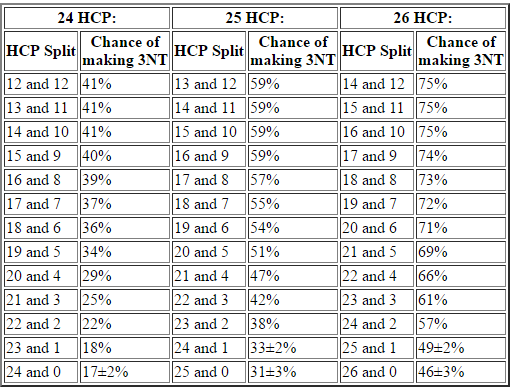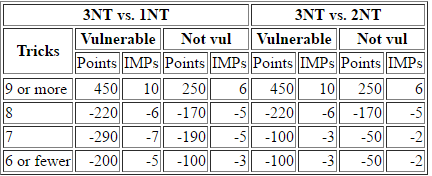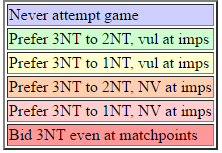Source: http://taigabridge.net
Relationship between success of 3NT contracts and how HCP are split between declarer and dummy
It is well known that, with two balanced or semibalanced hands facing each other and no 8-card major suit fit, we should bid game with 25 HCP (26, in some older books, mostly books that tell you to always add distributional points to high-card points even for notrump bidding.) «The books» make no distinction between raising 1C-1S-1NT (12-14) to 3NT with 13 points, raising 1NT (15-17) with ten, raising 1C-1S-2NT (18-19) with seven, and raising 2NT with five. Of course beginning bridge books often simplify advanced concepts in the interest of not confusing students. Should we revisit those basic point ranges for our raises? The answer, as we will see is «sometimes, at some forms of scoring, at some vulnerabilities.» Let’s start with that classic 25-HCP holding (and its two closest neighbors, 24 and 26 HCP) and see how our chances of 3NT vary according to how the high cards are split between the two hands:
[The fine print: unless otherwise noted, all results here are for 10,000 repetitions, giving us error bounds at the 95% confidence level of ±1% for probabilities and ±.02 for expected numbers of tricks. We allowed both opener and responder to be balanced or semibalanced (including 5-card majors and 6-card minors) but removed hands on which an 8-card major suit fit existed.]

Even or close-to-even splits of the high cards are best in each case. The penalty for an unbalanced high-card split is about 4% for having only 7HCP in the weaker hand; an additional 12% for having only 3HCP; and an additional 12% beyond that for having none at all. This accords with our knowledge about declarer play. It’s very common in 3NT to have card combinations that benefit from being led toward, e.g., finessing with an ace-queen. On most 3NT deals, you will desire one or two directed leads; only rarely will there be a need for three or more. When dummy is moderately strong, transportation is no problem; when dummy is extremely weak, entries are often in short supply.
Matchpoints
At matchpoint scoring, our only concern is whether a given bid will improve our score more often than it will hurt it. Given the choice between bidding 3NT and stopping in a partscore in notrump, bidding on improves our score when we can make 3NT, and hurts it when we cannot. So our decision is simple: bid on when our chance of making 3NT is greater than 50%. The simple textbook advice, «bid 3NT when you have 25HCP,» is spot on except in the case of extremely lopsided point distributions. In those extreme cases (21 opposite 4 and beyond), the raw statistics urge us to be conservative. In practice, we might do better looking at likely entries, rather than at the point count: that is, in response to a 20-21 2NT opening, passing with Qxx Jxx Jxx xxxxx but raising with Axx xxx xxx xxxx might make sense.
IMPs and total points
At other forms of scoring, our result is based on how much better or worse our score is compared to the score we would achieve in an alternative contract. It is well known that you should bid thin games more often at IMPs than at matchpoints, especially if vulnerable. Consider the standard simplifed textbook situation: you don’t know if you will take 8 tricks or 9. Bidding on will gain you 250 (NV) or 450 (V) points when you make game, and cost you 120+50=170 (NV) or 120+100=220 (V) points when you fail. Thus the standard textbook advice is to bid 40% games. The exact break-even points in this idealized situation are 5/(5+6)=44% (NV) and 7/(10+7)=41% (V) playing IMPs, and 170/420=41% (NV) and 220/670=33% (V) for total points. If that textbook assumption of always taking either 8 or 9 tricks were true, «always bid game 25 HCP» would be good advice, and staying out of 24-HCP games would be a break-even proposition.
In the real world that isn’t true. In declarer play problems we often see «either 8 tricks or 9» hands, but during a notrump auction we can almost never count our tricks so precisely. Sometimes we make more than 9 tricks (no problem for our calculations – we’re still only gaining the game bonus by bidding game) and sometimes we take 7 tricks or less. That does matter.
If we are deciding between passing 1NT and continuing to game, going down 2 or more is a larger mistake than going down 1 is. On the other hand, if we are deciding between 2NT and 3NT, going down 1 is the worst-case scenario; if we go down 2 or more in 3NT, we would have gone down anyway in 2NT. Here is how the mathematics stacks up:

To calculate when we belong in 3NT at IMPs, we need a little more detail from our simulation than was reported in the table at the top of this page: we need to know not just our probability of taking 9 or more tricks, but also our probability of making 7 and 8. Let’s try an example on for size: 24 HCP, divided 14-and-10. The simulation says we have a 41% chance of making game; a 35% chance of taking 8 tricks; a 18% chance of taking 7 tricks; and a 6% chance of 6 or fewer tricks.
Suppose first we are choosing whether to be in 1NT or 3NT (an unlikely situation at the table, but possible: maybe we are responding to a weak notrump, or maybe partner opened 1 and we can choose to downgrade and respond 1NT, or upgrade and make an inverted minor raise or 2
and we can choose to downgrade and respond 1NT, or upgrade and make an inverted minor raise or 2 response that will likely push us to game.) Not vulnerable, bidding game loses about 0.4 IMPs in the long run: 6 x .41 – 5 x .35 – 5 x . 18 – 3 x .06 = -.37. Vulnerable, bidding game gains about 0.4 IMPs in the long run: 10 x .41 – 6 x .35 – 7 x .18 – 5 x .06 = .44. (In practice we’re unlikely to know our partner’s exact point count at the 1-level so this is a bit artificial.)
response that will likely push us to game.) Not vulnerable, bidding game loses about 0.4 IMPs in the long run: 6 x .41 – 5 x .35 – 5 x . 18 – 3 x .06 = -.37. Vulnerable, bidding game gains about 0.4 IMPs in the long run: 10 x .41 – 6 x .35 – 7 x .18 – 5 x .06 = .44. (In practice we’re unlikely to know our partner’s exact point count at the 1-level so this is a bit artificial.)
Suppose now we are already at 2NT and are choosing whether to accept partner’s invitation and go on to 3. Now, bidding game is clearer: not vulnerable, we expect to gain 0.2 IMPs: 6 x .41 – 5 x .35 – 2 x .24 = .21. Vulnerable we have a solid gain of 1.3 IMPs: 10 x .41 – 6 x .35 – 3 x .24 = 1.28.
Despite the conventional wisdom about only bidding >40% games, if you are already at 2NT and are deciding whether to continue to 3NT, vulnerable at IMPs it can be right to raise with as little as about 32% chance of making game. A 24-HCP game is right unless the points break 20-and-4 or worse. (Nonvulnerable, you need 24 to break 15-and-9 or better, and 25 to break 22-and-3 or better.) Even at favorable vulnerability it isn’t right to routinely bid 23-HCP games. A complete table appears at the bottom of this document.
This has some important implications for your bidding system. In a Standard sequence like 1 – 1
– 1 – 2NT, opener’s jump shows 18-19 balanced and responder ostensibly has 6 to respond. If you like to respond on a lot of junky 4- and 5-counts, you will still want to drop your partner in 2NT; but if you always have an honest 6-count when you respond, you always belong in game if you are vulnerable, and you might as well be treating the jump to 2NT as forcing like it was in 1950s Standard American! (Confessions of being a matchpoint specialist: I played serious bridge for years without ever realizing this. Thank you to New York expert Justin Lall for bringing this phenomenon to my attention.)
– 2NT, opener’s jump shows 18-19 balanced and responder ostensibly has 6 to respond. If you like to respond on a lot of junky 4- and 5-counts, you will still want to drop your partner in 2NT; but if you always have an honest 6-count when you respond, you always belong in game if you are vulnerable, and you might as well be treating the jump to 2NT as forcing like it was in 1950s Standard American! (Confessions of being a matchpoint specialist: I played serious bridge for years without ever realizing this. Thank you to New York expert Justin Lall for bringing this phenomenon to my attention.)
Expected number of tricks
The unpleasant effects of unevenly distributed high cards are most obvious (and most important for our bidding strategy) when we inspect the success of a contract near its breakeven point (as for 3NT with 24-25 points, above.) However, the effects are universal, as can be seen we count expected numbers of tricks in notrump, rather than looking at the success of a specific contract.
One might expect that with 40 HCP in the deck and 13 tricks available, that adding a high-card point should add about 1/3 of a trick to the partership’s expectation. In fact, this is not true: throughout the partscore and game strength ranges, adding an extra point adds half a trick to your expectation. (The per-HCP benefits of extra high cards drop off rapidly in the slam zone.) The reason is that when you hold between 20 and 30 HCP already, any additional face card is likely going to be working in combination with other face cards. For instance, KQJ or AQT is worth 2 tricks while AQJ is worth 2½ tricks, if entries exist to finesse. In the slam zone an extra point may be wasted, and in an extremely weak hand, Jxx or Qxx is hardly better than xxx.
As with the contract success probabilities, the effect of an uneven break becomes rapidly more noticeable when the weaker hand falls below 7 HCP, and the cumulative effect reaches half a trick by the time the weaker hand falls to around 2 HCP. The following table shows the expected number of tricks as a function of hand strengths from 20 to 29 HCP:
The whole enchilada
As promised above, the complete results of the simulation, for 20 to 29 HCP totals. In the table are shown the chances of taking 7; 8; and 9 or more tricks for each hand strength. Subtract the total from 100% to find how often you will take 6 or fewer tricks. The cells are also color-coded according to what the optimal contract is:

Each category contains the one below it: any game worth bidding at MP is also worth bidding at IMP; any game worth bidding NV is also worth bidding V; if 3NT is better than 1NT, it is also better than 2NT.
The anomalies in the 27-0, 28-0, and 29-0 cells are due to small sample size. (n=100 for 29-0; n=300 for 27-0, 28-0, and 28-1; n=1000 for 25-0, 26-0, 26-1, 27-1, and 27-2; n=3000 for 23-0, 24-0, 24-1, 25-1, 25-2, 26-2, 25-3, and 26-3; otherwise n=10000.)
